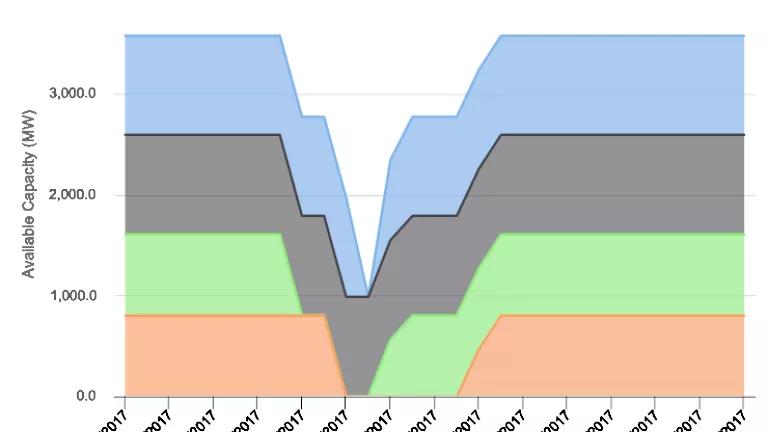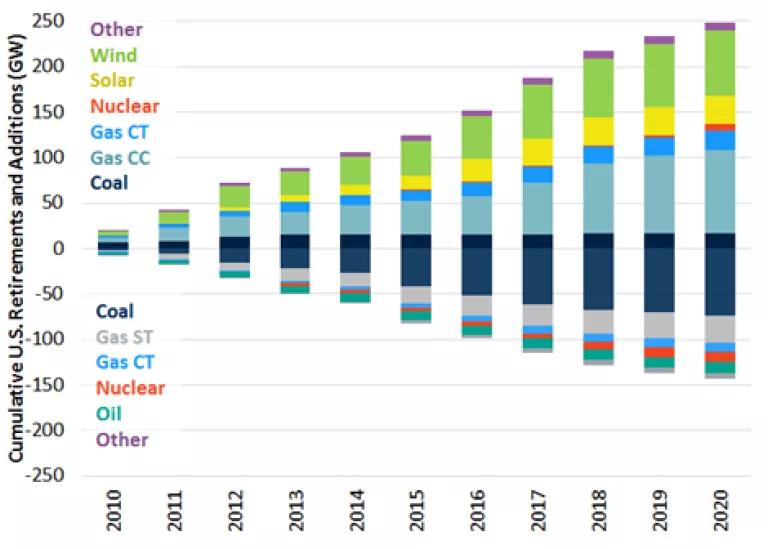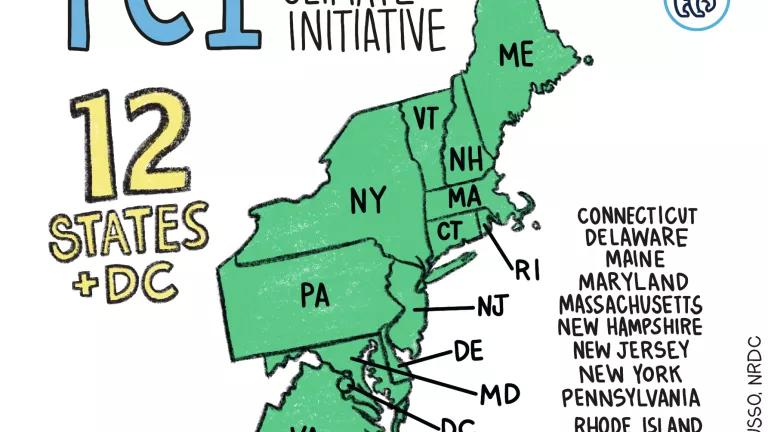
(NRDC analysis from SNL Energy data)
Whenever coal or nuclear interests claim America needs their fuel to avoid power blackouts, you should check your wallet. Every time they see a threat to their business, they claim the sky will fall unless they’re subsidized in some way. We’re seeing it again now, with the added twist that they claim the electric grid’s “resilience” is also at risk if we don’t pay more for their costly power. But bailouts will only stiff customers, increase carbon and other pollution, and stifle innovation, while adding few grid benefits that cleaner resources can’t offer at a lower cost.
These are several of the points I made in my testimony to Congress today regarding the state of the nation’s power grid. The hearing was held against the backdrop of a Trump administration determined to find extreme and unprecedented ways to rescue so-called “baseload” power, which has become too expensive to compete with other sources of electricity in some markets.
“Reliability” claims are a common scare tactic
Those defending polluting and/or costly power usually play the ‘grid reliability’ card when their business is threatened, but the card looks a little different each time. Two years ago, during the Clean Power Plan discussions, some said the U.S. grid would falter as we added more wind and solar power. Those claims got little traction, since the grid already can manage high levels of clean energy, and much higher levels are possible.
This year’s argument is that “baseload” power (mostly coal and nuclear) is uniquely reliable and more “resilient” than other sources such as natural gas, wind, and the sun. “Resilience” has become the latest buzzword in the electricity sector because it describes the ability to reduce the impact of extreme weather and other disruptions, such as the recent hurricanes, as well as the ability to bounce back quickly after a power/system failure.
In truth, however, the recent hurricanes have hammered home the lesson that all power sources are vulnerable to disruptions. For example, several nuclear units had to go offline for up to six days in Florida last month in preparation for Hurricane Irma, causing the loss of thousands of megawatts of power. Two nuclear units also went offline in Texas to prepare for Hurricane Harvey. Coal didn’t fare much better. During Harvey, one coal plant’s onsite coal pile became so saturated with rainwater that it couldn’t be used, forcing the plant to switch to natural gas for the first time in eight years. Freezing temperatures are another problem, such as when coal piles and power plants froze during the 2014 Polar Vortex in the eastern United States, incapacitating up to 25 percent of PJM’s coal fleet.
Conversely, wind performed well during both cold and warm extreme weather events, including Harvey, where wind plants near the Texas coast survived largely unscathed, despite 110 mile-per-hour winds. Further, it’s the distribution and transmission lines, not the power generation sources, that are the most common source of problems imperiling the grid’s resilience. Utilities have understandably invested in grid resilience in the wake of extreme weather events like Superstorm Sandy and Hurricane Katrina, and they have done so with investments to grid infrastructure, not costly payments to coal and nuclear.
Yet in the face of this clear evidence, the Trump administration, urged on by coal and nuclear interests, has opted for “alternative facts,” sowing confusion and suggesting the power grid will be imperiled if we don’t pay large subsidies to keep their outdated generators afloat.
The key point: with competition from a range of resources in addition to coal and nuclear in many areas of the country, a different mix of units can serve the system at different times. Coal and nuclear units are frequently not the least expensive option, and some regions of the grid operate quite well with little to no coal or nuclear power. In short, defining reliability needs first should drive policy choices.
Grid operators have better tools to protect reliability
What protects the power grid from blackouts when power plants or transmission lines are damaged and can’t operate? The list is impressive, including over 1,500 different reliability requirements for operating the system, and many other tools in the reliability toolkit. A highly interconnected network of transmission lines includes built-in redundancies so the grid can stay energized even if one or two lines or substations fail. Grid operators have reserves on stand-by ready to fill the power gap. Finally, when there truly is no other way to preserve reliability, consumers essentially pay power plants to stay online (after the grid operator determines a plant is necessary). Fortunately, these arrangements are few and far between, and they should stay that way.
We have more than enough power
The evidence is clear that our nation doesn’t face an energy supply deficit, so that can’t be a reason to further subsidize coal and nuclear power. The Department of Energy’s own study on reliability and electricity markets came to this conclusion. In the last seven years alone, our nation has added approximately 200,000 megawatts (MW) of new power plants (including many thousands of megawatts of rooftop solar), while retiring 123,000 MW of older, dirtier, and costlier power plants. Many thousands of megawatts will continue to be added to our power system in the future:

Projections don’t show any sign of this trend reversing. Over 166,000 MW of new power plants are planned or are underway in the nation’s three largest grid regions (PJM, MISO, and SPP), which also are home to most of our nation’s coal plants. Even if much of that power isn’t built (which often is the case as business plans change), those high levels signal investor confidence, not crisis. Energy efficiency also is squeezing more use out of every megawatt of power we produce and reducing the need for more power plants.
Department of Energy’s baseload bailout doesn’t make sense
Since coal and nuclear power are not uniquely resilient, their supporters cannot use resiliency as a pretext for subsidizing them. The Department of Energy wants the Federal Energy Regulatory Commission (FERC), the nation’s regulator of the interstate transmission grid, to give billions of dollars in new subsidies to baseload power plants without any proof that only plants with a 90-day on-site fuel supply can meet the need.
Subsidies for any fuel on the pretext of resilience or reliability would be an extremely costly mistake that would divert us from our urgent national priority to stop global warming and destroy power markets. A diverse coalition of energy interests who rarely are of one voice on FERC market design issues are deeply concerned with DOE’s approach. A better approach? Transforming the power grid to enable a low-carbon future, which will improve resilience in the long run by reducing the risk of extreme weather and other disruptive events.
This blog provides general information, not legal advice. If you need legal help, please consult a lawyer in your state.



